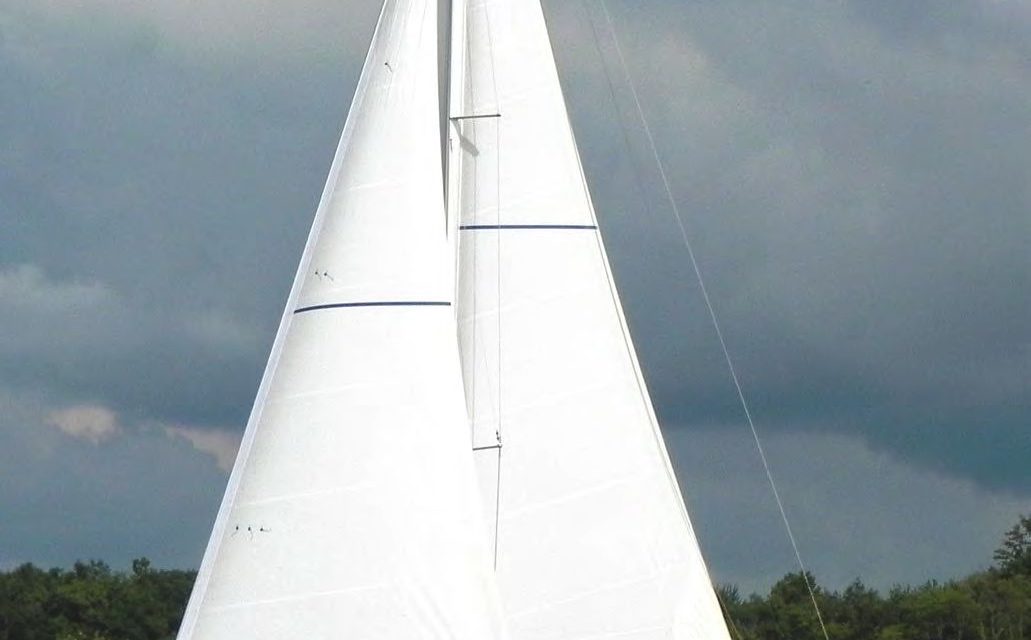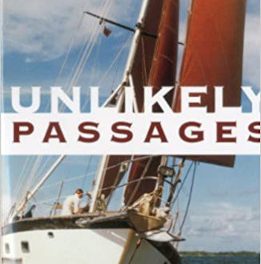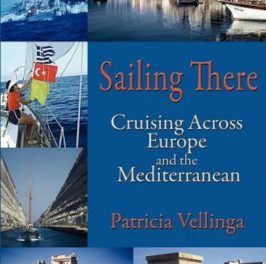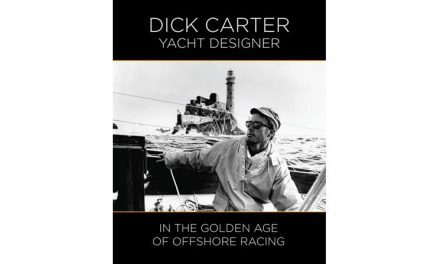A modern racer-cruiser with two helms
Issue 151: July/Aug 2023
 This 2013 Jeanneau Sun Odyssey 379 was less than 10 years old at the time of my review, providing a great opportunity to look at some of its modern design features that might be worth incorporating into any older boat refit.
This 2013 Jeanneau Sun Odyssey 379 was less than 10 years old at the time of my review, providing a great opportunity to look at some of its modern design features that might be worth incorporating into any older boat refit.
The boat’s owners are Thor and Cheryl Schaette of south central Illinois. Until recently, they had been mooring Schatz Sea (German for “treasure”) at Boulder Marina on Carlyle Lake. They recently retired and sold their speedy Farrier F-33 trimaran that was featured in a Good Old Boat review in the January/February 2020 issue; with the Jeanneau now ready to be their new liveaboard home, they hope to moor on the west coast of Florida or in North Carolina. My inspection and sailing was done in light air on Carlyle Lake in late 2022.
History
In 1957, hardware store owner Henri Jeanneau began his boatbuilding career with an outboard-powered wood dinghy. In the 1960s he began building with fiberglass. Jeanneau’s first sailboat, the Alize 20, came along in 1963 and was designed by E.G. van de Stadt. Through the early 1970s, most Jeanneaus were trailerable fiberglass sailboats, with larger boats appearing in the mid-1970s. A line of cruising boats was introduced with the Daniel Andrieu-designed Sun Odyssey 42 in 1986. Altogether there have been approximately 173 Jeanneau sailboat models in cruiser-racer, cruiser, and catamaran configurations, plus some one-off products, ranging from 16 to 65 feet. After three ownership changes, in 1995 Jeanneau was acquired by Groupe Beneteau, which is based in Saint-Gilles-Croix-de-Vie, France. Production of the Marc Lombard-designed Sun Odyssey 379 began in 2011.
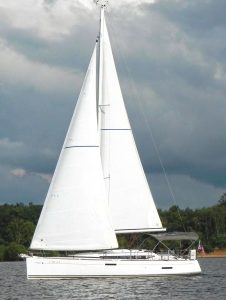
Flat sheer, plumb bow, and hard chines define the current French styling of midsize sailing yachts. Note the absence of a roach in the furling mainsail.
Design
Jeanneau has used a wide variety of naval architects to design its boats, but they mostly have followed a familiar modern appearance of near-plumb bows, short overhangs, and low, sleek cabin trunks, and they typically carry their wide beam well aft. Owing to Beneteau’s ownership, there are similarities in design and construction between brands, and nowhere is this more evident than in the incorporation of hard chines in certain models. The claim that this feature significantly contributes to form stability is debatable, but it does increase panel stiffness somewhat and also interior volume at an important location. Plus, it is a distinctive design signature.
The displacement/LWL ratio of 166 means the 379 has a fairly flat bottom that will achieve good speeds. As a rough idea of its comparative speed, the few registered in Performance Handicap Racing Fleets (PHRF) fleets in the U.S. rate between 105 and 111 seconds per mile, compared with an older J/37 at 72 and an Island Packet 37 at 186.
The 379 was offered in two cabin layouts and three different drafts. The threecabin arrangement has two staterooms aft and a narrower head, while the review boat version has a single double berth, a large storage area in lieu of the port stateroom, and a larger head well aft. Of the three keel options, which include a swing keel, Schatz Sea has the fixed shoal-draft keel, which is the model in nearly all the magazine reviews. The swing keel is also described as a lifting keel, but it can’t be both so we’re not sure what to make of it. And to further confuse, the deep draft model apparently has a single rudder and helm.
Construction
Jeanneau and Beneteau are leaders in developing efficient, modern facilities that enable streamlining the production processes. The 379’s fiberglass hull is single skin, meaning there is no core. Jeanneau employs what it calls the “Prisma” process, whereby decks are injection-molded with gelcoat on both sides and end-grain balsa as a core. Hulls are handlaid fiberglass; the larger models over 50 feet are resin-infused, which is a more advanced process that eliminates volatile organic compounds in the workplace and better controls the resin/ glass ratio. Interior pans and overheads eliminate a lot of wood parts and reduce labor. The synthetic toerail is difficult to distinguish from teak.
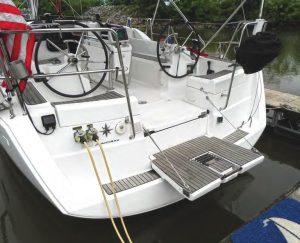
One of many clever features on the 379 is the drop-down stern platform with built-in telescoping swim ladder. Below the platform is a plug with a pull-out emergency rope ladder, allowing a person to exit the water even if the
platform is retracted.
Rig
The rig is a fractional doublespreader rig with roller-furling headsail; Schatz Sea has an in-mast furling mainsail. While mainsail furling inhibits performance, it certainly aids in reducing the effort to sail. The shrouds are mounted well inboard, making passage by the rigging easy. The jib sheets are readily at hand to the helmsperson, with self-tailing winches. The sheet leads are on line-controlled jib block cars that reach the two helms as well. A simple boom brake is adjustable from either side, as is the main sheet.
Deck
Forward there is a large anchor locker, windlass, and short bow roller for all your ground tackle needs. Aft, the cabin top handholds are sleek and built in like those in the saloon. However, the cabin trunk is so low that the handholds are essentially useless for going forward in a seaway. I found that the large-diameter mast shrouds made the best handholds. While moving fenders from one side of the boat to the other, going forward around the mast was the easiest path. Though on Schatz Sea all lines are led aft and sail furling requires no work outside the cockpit, a boat with a conventional mainsail would benefit from a mast pulpit.
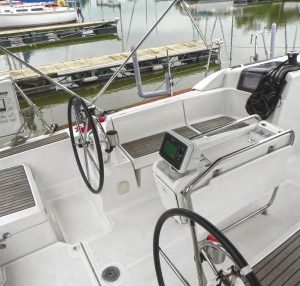
The centerline cockpit pedestal is insulated and serves as a cooler as well as storage space. That’s also where the multidisplay instrument is mounted.
The transom has a platform and a ladder that easily lowers and raises via a cleated line. When docked stern-to, it is super easy to get aboard as the twin wheels are out of the way and the center pedestal offers good handholds. The transom also features a small step-lip and an emergency overboard ladder.
Jeanneau has mounted hard-point tiedowns along the sidedecks for tether attachments and in the lazarette for dinghy tiedown. The lazarette also holds large fenders or a deflated dinghy. The two-bottle propane locker is readily at hand for easy tank exchange, one of many well-thought-out details that also include a life raft well.
The Sailing Patio
With a wide beam aft, the cockpit is catamaran patiowide. This is mostly a plus due to the clever stainless steel and white plastic fixed steering pedestals port and starboard. Underway, the footrest tube at the bottom is great for bracing while heeled. However, if you are seated forward of the pedestal, bracing is iffy. Grabrails at the top of the pedestal make getting up from the seats easy and secure. Additional grab bars are forward of each wheel. The pedestal tables swing up and easily lock in place with supports. To lower them, you just press a release button. Another sealed storage area at the forward end of the pedestal is a good spot for binoculars and such.
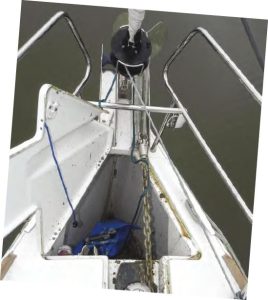
The bow area is configured for two anchor rollers, stowage, and a windlass concealed by the hatch cover — all very clean.
The square sail-sized bimini top on Schatz Sea is mounted quite high. I was able to stand on a seat to take photos! Due to its width, shade is usually available somewhere in the cockpit. Thor wanted flexible solar panels on top of the bimini but loathed the thought of mounting holes or sewn patches, so he cleverly employed round matching magnets over and under the canvas to hold them in place.
The companionway makes for a secure spot to stand and work the two self-tailing winches that flank it and operate the many lines that lead aft to them, then into two large net bags to contain the tails. A powered winch handle or powered winch would be nice for use with the mainsail’s in-mast furler that otherwise needs a lot of winch grinding in and out. The companionway dropboard is dark translucent acrylic with slanted vent holes that prevent rain from entering, but not bugs.
Belowdecks
Two interior arrangements were offered, one with a V-berth and mirror-image double cabins aft, and a second, as on Schatz Sea, with a single double berth and a larger head. The shower is separate from the vanity within this space, but not separate from the head itself.
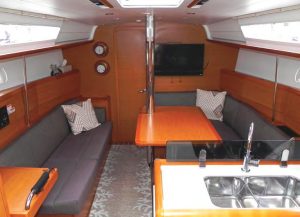
Beneteau, which owns the Jeanneau brand, is a master at streamlined, efficient production, with CNC-cut veneered wood panels and composite
modules usually well hidden by clever engineering.
The saloon is neat and modern, with light-colored veneers. The forward cabin is sufficiently roomy and private. Great light and ventilation prevail. The overhead has flush-mounted handholds that are quite good, as are the handholds below the windows.
All storage is hidden behind doors with button latch pulls. The overhead LED saloon lights have three-way switches — a great feature. Other small lights operate with tiny toggle switches that you would need to get accustomed to. All exposed bolts and screws are covered with caps.
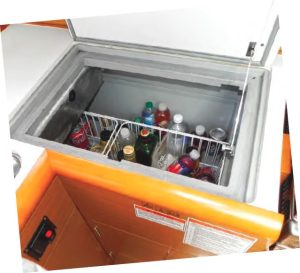
The icebox is set in the counter between the sink
and stove. Wire racks help organize contents.
I absolutely love the overhead hatches with their built-in shades and bug screens that retract completely out of the way or may be used in combinations. There is a shade in the side window for the quarter berth that retracts as well. Opening portlights are provided for this berth and for the “garage” via cockpit locations. The quarter berth also has an overhead hatch for good ventilation and light.
My wife and I were overnight guests on Schatz Sea. We slept in the roomy forward cabin where the built-in air conditioning was too cold, so I blocked the vent. I like boats with an aft head, and the 379’s head was quite easily used underway and is roomy and airy. The wet locker is just forward of the head, where it drains into the bilge.
While the port cockpit seat locker offers a large storage space, it does not open to the interior. Under it, accessed through the head, is the garage, an aptly named space. A large door permits easy access to what in other boats would normally be a full sleeping cabin. Sliding removable drawers in a rack offer good storage for small items. Access to batteries, engine, systems, and anything big is found here, although you may need to dig a bit after you fill it with stuff. This garage is a sailor’s delight.

Access to the bottom of the icebox is solved by a well-insulated door.
Underway
The twin rudders are protected by the shoal-draft bulb-wing keel. On Jeanneau’s 379 web page there are photos of the shoal-draft version sitting upright and dried out on a flat beach, balanced on the wing and twin rudders. Under power in reverse, there is little prop walk and plenty of rudder power. The previous owner added a bow thruster, but Thor has found it is not necessary. He hasn’t removed it, but would rather have better sailing performance without the “big brick and hole in the bow.”
The three-cylinder, 29-hp Yanmar diesel engine coupled to a saildrive was very smooth and quiet. Its single-lever control was set up for the starboard wheel.
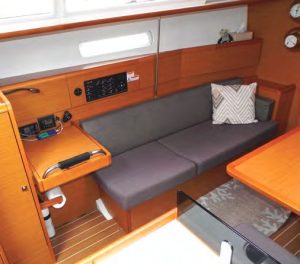
The compact nav station is minimal for a cruising yacht; one sits at the end of the port settee. Regarding hidden fiberglass modules,
note the barely visible section of the floor grid.
Thor reports that once the 379 heels over onto its hard chine, it will stabilize there and have a neutral helm. He says it pays to fall off a bit from hard on the wind and to crack the sheets a bit to get this nicely balanced spot. But if heel increases past the chine, the 379 will behave like any other boat and need more attention to the helm and reduced sail.
The leather-wrapped wheels had a light to moderate feel — it wasn’t quite fingertip control, but a light hand was all that was needed. Some of this may be due to the friction in the system of two wheels and two rudders. I found it comfortable to steer standing or sitting to the side; however, I would miss the relaxed seating of a leeward cockpit seat to nestle down into to steer one-handed while keeping an eye on the jib. Visibility forward is great from either wheel. Schatz Sea has a wind indicator gauge and compass at each wheel, but the nav and depth electronics are on the table pedestal control head. While this touch screen can be turned, I found myself going over to have a look fairly frequently.
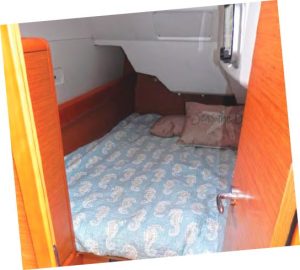
A closer look inside the quarter cabin with its one portlight opening into the cockpit footwell. There is floor space to sit and close the door.
Conclusion
“Different strokes for different folks” is a good saying. Some may scoff at the 379’s huge cockpit, wide aft beam, and accoutrements as not being sailorly. But the manufacturers of modern yachts know who their customers are, and the Sun Odyssey 379 was designed for those who want spacious accommodations above and below deck for entertaining.
Thor and Cheryl are not strangers to sailing for sailing’s sake, but when it came time to retire, Thor carefully listed all the boxes he needed checked to live on a boat, and the Sun Odyssey 379 came out on top. They had the good fortune to find a newer, barely used boat in their price range to fulfill their liveaboard dream.
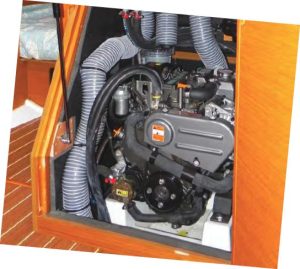
The front of the Yanmar diesel auxiliary is easily accessed through a gas-spring supported door.
Also, there is a wide range of Jeanneau Sun Odyssey lengths that can be found with similar features and different prices. The 379s sold new for under $200,000, and few used ones are currently available in the U.S. I found several for sale overseas for around $150,000 USD.
Some of the innovative features found on the 379 might inspire you to “modernize” your good old boat.
Allen Penticoff, a Good Old Boat contributing editor, is a freelance writer, sailor, and longtime aviator. He has trailer-sailed on every Great Lake and on many inland waters and has had keelboat adventures on fresh and salt water. He owns an American 14.5, a MacGregor 26D, and a 1955 Beister 42-foot steel cutter that he stores as a someday project.
Thank you to Sailrite Enterprises, Inc., for providing free access to back issues of Good Old Boat through intellectual property rights. Sailrite.com

